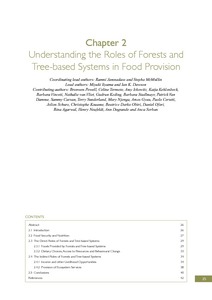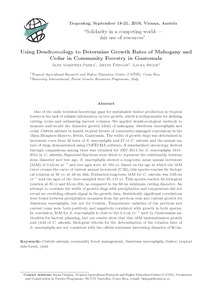ciencias forestales
AGROVOC URI:
The wealth of the dry forests: can sound forest management contribute to the millennium development goals in Sub-Saharan Africa?
Dry forests in Sub-Saharan Africa (SSA) cover approximately 43% of the continent. They are inhabited by nearly 236 million people, many of these the poorest in the world. A majority of the population of these regions is dependent on traditional energy sources (i.e., firewood, charcoal and organic wastes), subsistence farming, generally free-ranging livestock, and products harvested from the dry forests. Growing pressure on dry forest resources to meet human and socioeconomic development needs mean that dry forests are increasingly being utilised unsustainably.
Trade-offs and alternative livelihoods of the forest-dependent people in the Malinau research forest
Understanding the roles of forests and tree-based systems in food provision
Forests and other tree-based systems such as agroforestry contribute to food and nutritional security in myriad ways. Directly, trees provide a variety of healthy foods including fruits, leafy vegetables, nuts, seeds and edible oils that can diversify diets and address seasonal food and nutritional gaps. Forests are also sources of a wider range of edible plants and fungi, as well as bushmeat, fish and insects.
Turning ideas into action: planning for non-timber forest product development and conservation
Effective planning for non-timber forest product (NTFP) development and conservation will ensure the most effective use of scarce resources and maximise the likelihood that the objective will be obtained. NTFP development and conservation is usually a long-term activity and involves the collaboration of a number of different, quite independent parties. This has implications for the kind of planning that needs to be undertaken.
Using dendroecology to determine growth rates of mahogany and cedar in community forestry in Guatemala
One of the main technical knowledge gaps for sustainable timber production in tropical forests is the lack of reliable information on tree growth, which is indispensable for defining cutting cycles and estimating harvest volumes. We applied dendroecological methods to measure and model the diameter growth (dbh) of mahogany Swietenia macrophylla and cedar Cedrela odorata in humid tropical forests of community-managed concessions in the Maya Biosphere Reserve, Petén, Guatemala. The width of growth rings was determined in increment cores from 32 trees of S. macrophylla and 27 of C.
When REDD+ goes national: a review of realities, opportunities and challenges
The development of national REDD+ strategies has progressed. Common challenges include establishing appropriate national institutions that link into ongoing processes; ensuring high level government commitment; achieving strong coordination within governments and between state and non-state actors; designing mechanisms to ensure participation and benefit sharing; and establishing monitoring, reporting and verification (MRV) systems. The different agendas of actors involved in policy formulation at the national level reflect those at the international level.




